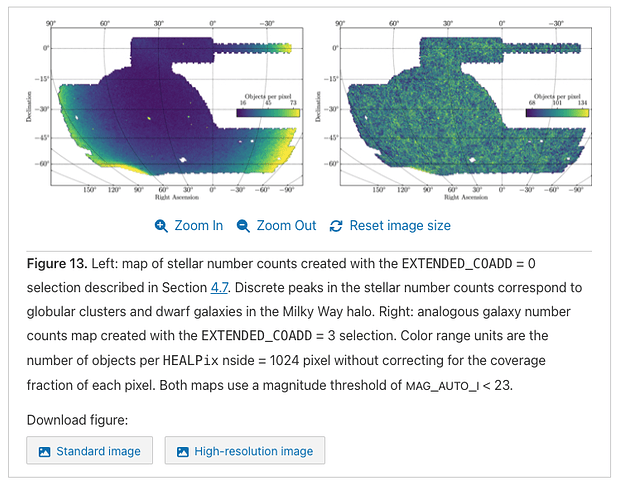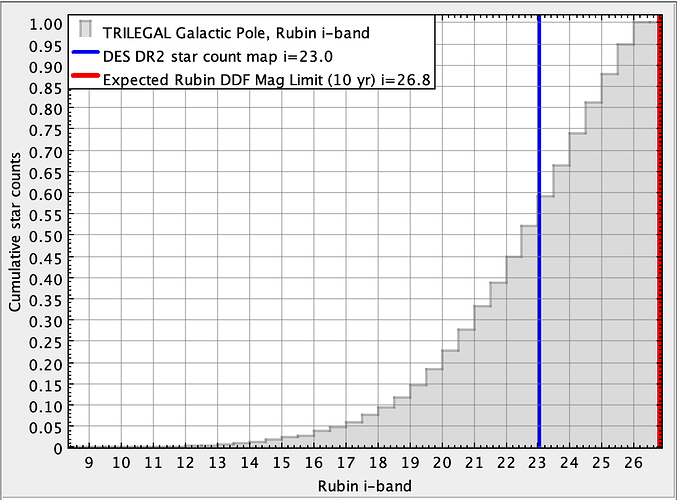I am looking for stellar population counts by Stellar Class or mass or temperature for targets that will be observed in the pointings for the 5+1 DDF surveys. I have pulled data from the TRILEGAL Rubin/LSST sim and the GAIA universe sim, but I cannot find anything other some ten’s of thousands of stars in the 10 sq degrees around the RA/DEC center of each DDF using the GAIA sim. I don’t have anything to compare, so I don’t know if those numbers are a good portion, a small portion, an infinitesimal portion of the real population.
Hi @sdcorle1, thank you for your post. Thanks for sharing your work. Could you clarify if the TRILEGAL results you mentioned came from the online TRILEGAL interface (with LSST filter curves) or from the NOIRLab LSST SIM service? The TRILEGAL code outputs include stellar age, initial mass, and metallicity, so binning by mass or temperature after applying the DDF magnitude limits should give the distributions you’re after.
Hi @sdcorle1,
Yes, this is a very interesting question!
I am not a stellar populations expert, but I would basically trust the outputs of the TRILEGAL. It is pretty much the standard Milky Way Galaxy simulator code and it has been well tested and updated over the years. In its current webform version – TRILEGAL 1.6 input form – it even has pretty up-to-date LSST filter curves (r1.9, September 2023).
I ran this webform version of TRILEGAL for the Galactic Pole and plotted the cumulative star counts for Rubin r-band. On this plot, I also indicated measured r-band mag limits for the SDSS imaging data, for the Dark Energy Survey Data Release 2 (DES DR2) wide-field coadds, and for the estimated 10-year Rubin DDF coadds. I think, very roughly, one can scale from the SDSS or DES DR2 total star counts to get the expected star counts for the 10-year Rubin DDF coadds.
The results: it looks like the Rubin DDFs will capture about 98% of stars to the Galaxy’s edge, whereas the DES DR2 Wide-Field coadds capture about 70%, and the SDSS captures about 35-40% of stars.
I hope this helps!
Best regards,
Douglas
PS: The cumulative star counts in the above plot have been normalized to the total star counts; hence the values go from 0.00 (no stars) to 1.00 (all the stars) on the Y-axis.
Further, I found in the DES DR2 paper a plot of star counts for point sources brighter than i=23.0, binned spatially by healpixels of NSIDE=1024 (roughly 11.8 square arcminutes in area):
I re-did the above cumulative histogram plot for i-band, indicating the a vertical line at i=23.0 (for comparison with the DES DR2 star count map) and the expected i-band limit of the Rubin 10-year DDF field coadds (i=26.8):
I think you can just multiply the DES DR2 star count map by a factor of 2 to get a rough idea of the star counts (per NSIDE=1024 healpixel) for the Rubin 10-year-depth DDF field coadds – so, typically ~30 DES DR2 stars per NSIDE=1024 healpixel = ~60 Rubin DDF stars per 11.8 sq arcmin = ~18,000 DDF stars per sq degree (if I did my math right! ![]() ).
).
@DouglasLTucker @plazas The TRILEGAL sim that I am using is lsst_sim.simdr2 which is housed at NoirLab. Yesterday, I was finally able to get that sim’s version of the size of stellar population for each of the DDF’s. The total population for all 6 DDF’s is estimated to be about 350,000 by this sim. This would compare to ~ 1 million (18,000 per sq degree x 10 sq degree x 6 DDF fields) from Douglas’s calculations. However, I know that the TRILEGAL sim only has about 3 billion of the expected 17 or so billion stars that make up the LSST inventory. So, I would expect to get a much smaller count than Douglas’s estimate. I have to go with TRILEGAL because I can derive the specific stellar classes from TRILEGAL and I need that information for my process. So, I will caveat that my numbers are probably low by a factor of 3 to 5.
By the way, this is not the first time that I have had operational problems with data stored at NoirLab. I believe that the cause may lie with the time that I am working, which is usually off-hours and week-ends. It is possible that I was bounced by some big batch or maintenance job running on the NoirLab database.
@DouglasLTucker Thanks for doing this analysis. It gave me a lot of confidence that I was in the right ball park.


